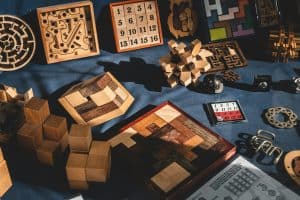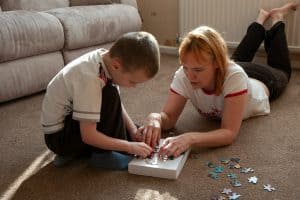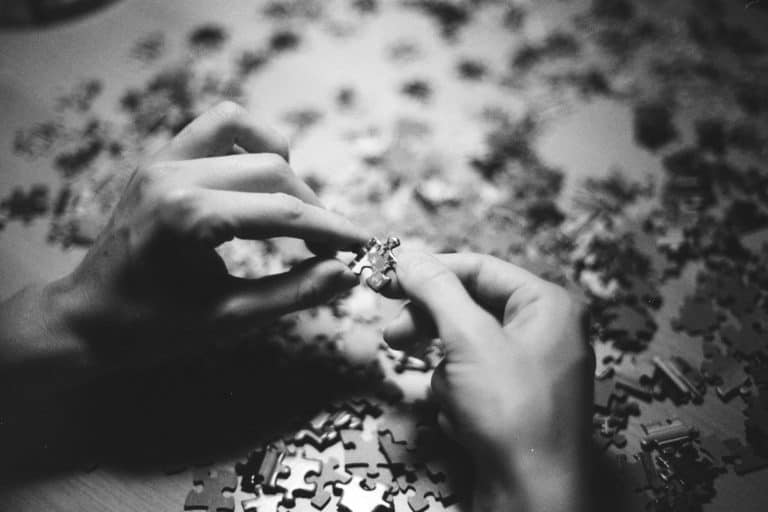Learning how to create a puzzle solving space in your home isn’t just about setting aside a corner for brain teasers; it’s about crafting an environment that enhances focus and ignites creativity. Whether you’re a fan of classic jigsaw puzzles, intricate escape room challenges, or engaging word puzzles, having a special spot to lose yourself in these activities can transform your approach to problem-solving.
I’ve discovered that the key to a perfect puzzle space lies in balancing comfort with inspiration. It’s not merely about the physical space but also about how this area can mentally prepare you for the task at hand. From selecting the right lighting to choosing comfortable seating that doesn’t distract from the mental gymnastics, every detail counts.
Moreover, integrating elements that stimulate your senses can elevate your puzzle-solving efficiency. Imagine an area where every detail, from the wall color to the subtle background music, is geared towards maximizing your concentration and enjoyment. Let’s dive into how you can create such an inviting and productive space right in your home.
How to Create a Puzzle Solving Space in Your Home
Choosing the Right Space for Puzzle Solving
Creating a dedicated puzzle-solving space at home is vital to enhance your ability to focus and solve problems efficiently. In this section, I’ll guide you through selecting the ideal space for your puzzle-solving endeavors and how to optimize it for maximum comfort and functionality.

Considerations for Selecting Your Puzzle Room
When choosing the right room for your puzzle-solving activities, several factors come into play. First, consider the size of the space. Puzzle solving, especially when involving large jigsaw puzzles or elaborate escape room puzzles, often requires a substantial amount of room. Therefore, ensure the space you select can accommodate all the puzzles comfortably.
Second, think about the room’s location. A quieter area of the house, away from the hustle and bustle of family activities, offers the perfect spot. A spare room, a section of your basement or attic, or even a corner of your home office could work excellently. It’s important that this area is somewhat isolated to minimize distractions and maximize concentration.
Additionally, the room’s purpose matters. If you’re aiming to create an escape room, for instance, consider rooms with unique features such as multiple sections or hidden spaces. These can enhance the overall experience by adding layers of challenge and intrigue. For a more general puzzle room setup, simplicity works best — a clear space with minimal clutter will keep you focused on solving puzzles.
Optimizing Lighting and Comfort
Lighting plays a crucial role in any puzzle-solving space. Poor lighting not only strains the eyes but can also affect mood and mental stamina. Ideally, incorporate multiple layers of lighting; overhead lights for general illumination, task lighting such as table lamps or floor lamps to brighten specific areas, and adjustable lamps to control the direction and intensity of light based on what you need.
Comfort is another key element that shouldn’t be overlooked. Choose ergonomically designed chairs that support long periods of sitting. Ensure the furniture allows for easy movement and adjustability. Additionally, the temperature of the room should be conducive to long sessions of brainstorming and puzzle solving — not too hot or too cold.
A well-thought-out puzzle room can transform your puzzle-solving experience from pleasant to outstanding. By considering these aspects of room choice and environmental comfort, you’re setting yourself up for rewarding and enjoyable puzzle-solving sessions right in the comfort of your home.
Essential Tools and Accessories
When designing a dedicated puzzle-solving space in your home, ensuring you have the right tools and accessories can transform a mundane area into a true own escape room or puzzle haven. Here I’ll go over essential elements that not only boost the function and flair of your space but also enhance your puzzle-solving experience.
Puzzle-Proofing Your Furniture
Choosing the right furniture for your puzzle area involves more than just aesthetics; it’s about functionality and durability too. For instance, using furniture with smooth and wide surfaces such as a dining room table ensures ample space for spreading out jigsaw puzzles or escape room games. To protect surfaces from scratches and spills, consider fitting table covers or using a roll-up puzzle mat which can safely secure all your puzzle pieces and be easily stored away when not in use. This setup not only preserves your furniture but also provides a smooth and clean area to work with, enabling puzzlers to focus entirely on solving the challenges at hand.
Storage Solutions for Puzzle Pieces
Effective storage solutions are crucial to keeping your puzzle area organized and efficient, especially if you delve into larger, more complex puzzles. Options like segmented drawers, clear storage boxes, or custom shelving allow for easy sorting and access to puzzle pieces and escape room components. These systems help manage everything from jigsaw pieces to small props used in DIY escape room puzzles. Additionally, using labeled containers can save time and avoid the frustration of misplacing crucial game elements. This organization extends beyond mere convenience; it enhances your whole puzzle-solving process, ensuring all the puzzles and tools you need are within reach, thus keeping you immersed in your game experience.
By integrating the above tools and accessories into your puzzle space, you create not just a functional area but a sanctuary where creativity, focus, and problem-solving can thrive.

Designing Engaging Puzzle Challenges
Designing puzzle challenges that captivate and challenge can transform an ordinary room into an invigorating escape haven. Here’s how I step up the interactive and immersive quality of the puzzle-solving experience right in my own home.
Crafting Custom Puzzles for Your Space
Creating custom puzzles tailored for my puzzle area elevates the excitement and uniqueness of my home setup. I focus on integrating elements that blend seamlessly with my puzzle room’s theme while challenging the ingenuity of every puzzle solver who steps into the space. For instance, converting objects like a dining room table or a picture frame into components of a larger puzzle sequence can create a multi-functional environment that is both a living space and a creative puzzle zone.
Incorporating Various Puzzle Types
In my home escape room, it’s essential to cater to diverse preferences and skill levels by incorporating a wide range of puzzle types. From jigsaw puzzles that require spatial reasoning to escape room puzzles involving secret codes and hidden messages, the variety keeps participants engaged and eager to solve the next clue. Leveraging different puzzles not only challenges participants in various ways but also makes the overall experience more dynamic and enjoyable.
Every puzzle game becomes a story unfolding, making the whole space not just a room, but a narrative each solver becomes a part of. By considering these elements, I design challenges that are not only fun but also deeply engaging, ensuring everyone leaves with a great sense of accomplishment and a story to tell.
Theme and Aesthetics
Selecting the right theme and aesthetics is crucial when creating a puzzle-solving space in your home. This section will guide you on choosing a theme that resonates with your interests or specific puzzle games and decorating techniques that will enhance the immersion and overall experience.
Selecting a Theme for Your Puzzle Room
Selecting a theme for your puzzle room involves aligning it with the type of puzzles you plan to include or a particular storyline you love. Themes such as secret agents, ancient Egypt, or a haunted house not only add intrigue but also provide a comprehensive context that makes puzzle design and selection more intuitive. For a family-friendly approach, themes based on popular books or movies can engage participants of all ages. Themes can set the mood and offer unique challenges that correlate with the narrative, transforming your puzzle room into more than a game space—it becomes an adventure zone.
Decorating to Enhance the Puzzle Experience
Decorating your puzzle room to match the theme isn’t just about aesthetics; it’s about creating an environment that boosts the puzzlers’ experience. Start with wall colors or wallpapers that match the theme—deep blues for an oceanic adventure or sandy textures for an Egyptian tomb. Lighting plays a crucial role; soft, dimmed lighting might be perfect for a haunted house theme, while bright, focused lights suit a scientific lab. Props and furniture also contribute significantly. Imagine incorporating bookshelves filled with secret compartments in a wizard’s library or laboratory counters for a mad scientist’s lab.

Decor elements are not only visually appealing but they also become part of the puzzles. Picture frames in a secret agent room might hide clues behind them, or a beautifully ornate box on a desk could hold the key to the next challenge. By integrating decorative items as functional components of your puzzle design, you ensure that every aspect of the room contributes to a cohesive and engaging game flow.
Integrating the chosen theme with the puzzle designs provides an immersive experience, ensuring every game is memorable and uniquely challenging. By following these tips on selecting the right theme and enhancing it through deliberate decoration choices, you’ll create a captivating puzzle room that offers both fun and an artistic touch, inviting players to return to new puzzles in a familiar, themed setting.
Safety and Accessibility
Creating a puzzle-solving space at home involves more than just aesthetics and themes; it’s also crucial to ensure it is safe and accessible for everyone who might use it. Let’s delve into making your puzzle area not only engaging but also secure and inclusive.
Ensuring Safety During Game Play
When designing your puzzle area, always prioritize safety. The right flooring is critical; consider anti-slip options to protect everyone, especially if children or elderly family members are involved. Stable furniture that doesn’t easily tip over when leaned against is a must-have. Additionally, ensure all wiring, if using electronic components like lighting for an escape room game, is safely tucked away to prevent trips and falls. If you integrate any physical elements like an obstacle course or hidden compartments, double-check that they are securely installed and do not pose a hazard.
Adequate lighting is essential not just for ambiance but also to ensure participants can safely navigate the space. I recommend soft but ample lighting to avoid eye strain while providing enough visibility for everyone to move around safely without mishaps.
Making Your Puzzle Titanic Ship Accessible for All
Accessibility is crucial to ensure all participants, regardless of ability, can enjoy the puzzle-solving experience. For those with mobility issues, ensure there is ample space for a wheelchair or mobility aids to maneuver easily. Consider installing ramps if your puzzle room has any elevation changes.
For puzzle solvers with visual or hearing impairments, incorporating diverse puzzle types can make the experience enjoyable and inclusive. Use puzzles that leverage different senses, like tactile puzzles or sound-based clues, to accommodate all participants effectively.
Remember, accessibility enhancements not only make your puzzle room inclusive but can also enhance the overall experience by providing a variety of ways to engage with the games. Adjusting your setup to be more accessible will certainly make the puzzle-solving adventure welcoming and enjoyable for everyone in your home.
Crafting a puzzle-solving space in your home isn’t just about fun and games—it’s about creating an environment that enhances your problem-solving skills in a safe and inviting setting. By carefully considering the layout, lighting, and furniture, you’ve taken the first steps towards building an engaging area that caters to the needs of all family members. Remember the importance of accessibility and safety to ensure that everyone can participate and enjoy the space. With these elements in place, you’re ready to dive into hours of puzzle-solving entertainment. Embrace the challenge and enjoy your new puzzle haven!
Frequently Asked Questions
How should I set up a dedicated puzzle-solving space at home?
Create a comfortable area with good lighting and minimal distractions. Choose furniture that supports your activity, like a table with ample surface area for spreading out puzzle pieces. Ensure the room is well-lit to prevent eye strain.
What are the essential tools for puzzle-solving?
Essential tools include a puzzle mat for easy storage and transport of your puzzle, sorting trays to organize pieces by color or shape, and a magnifying glass to help with smaller pieces.
How can I theme my puzzle-solving space?
Align the theme of your space with the types of puzzles you enjoy or your personal interests. For example, a nature-themed space with plant decor can enhance the experience of solving landscape puzzles.
What are the best decorating techniques for a puzzle room?
Incorporate comfortable seating, themed decorations, and soothing colors to create a relaxing environment. Wall art or posters related to puzzles or themes that interest you can also enhance the ambiance.
How do I ensure safety in my puzzle area?
Ensure that all furniture is stable and secure, check that there are no tripping hazards, and keep the space free of unnecessary clutter. Make sure all electrical installations are safe, and there’s adequate lighting throughout.
How can I make my puzzle room accessible for everyone?
Incorporate wide pathways, adjustable lighting, and clear, unobtracted access to the puzzle-solving table. Consider tactile puzzles for those with visual impairments and provide seating options for those who might need to rest.
By carefully designing and outfitting your puzzle-solving space, you can create a sanctuary that enhances your puzzling experience while being safe and accessible for any puzzle enthusiast in your household.

